There are many different treatment options available for individuals diagnosed with post-traumatic stress disorder (PTSD). However, one of the most effective and widely used methods is cognitive behavioral therapy (CBT). Now the question arises how to treat PTSD with CBT?
In this comprehensive guide, we will discuss the key components of CBT and how it can be used to effectively treat PTSD.
Read now to learn more.
How to treat PTSD with CBT?

CBT is a type of psychotherapy that focuses on changing negative thought patterns and behaviors. It is based on the idea that our thoughts, feelings, and behaviors are all interconnected and can influence each other. In the case of PTSD, individuals may have experienced traumatic events that have led to distorted thinking and maladaptive behaviors.
The goal of CBT is to help individuals identify and challenge these negative thoughts and behaviors, leading to more adaptive coping strategies and improved overall well-being.
Key Components of CBT for PTSD
There are three main components of CBT that are used to treat PTSD: exposure therapy, cognitive restructuring, and stress management techniques.
Exposure Therapy
Exposure therapy is a type of behavioral therapy where individuals gradually expose themselves to memories or situations that trigger their PTSD symptoms. This may include talking about the traumatic event, writing about it, or even physically exposing oneself to similar environments.
The idea behind exposure therapy is that by repeatedly confronting the traumatic memories or triggers, individuals can learn to cope with them in a healthier way and reduce their intensity over time.
Cognitive Restructuring
Cognitive restructuring involves identifying and challenging negative thought patterns related to the traumatic event. This may include beliefs such as “it was my fault” or “I am not safe.” By examining the evidence and reframing these thoughts, individuals can learn to think in a more balanced and realistic way.
Stress Management Techniques
Stress management techniques, such as relaxation exercises, deep breathing, and mindfulness practices, can help individuals reduce the physical symptoms of anxiety and stress that often accompany PTSD. These techniques can also be helpful in managing any co-occurring conditions, such as depression or anxiety disorders.
How Effective is CBT for PTSD?
Research has shown that CBT can be highly effective in treating PTSD. A meta-analysis of 26 studies found that individuals who received CBT had significantly reduced symptoms of PTSD compared to those who did not receive any treatment.
Furthermore, research suggests that 53% of individuals who received CBT for PTSD no longer met the criteria for a diagnosis after treatment.
Benefits of CBT for PTSD
In addition to reducing symptoms of PTSD, CBT can also have other positive impacts on individuals’ lives. These may include improved relationships, enhanced problem-solving skills, and increased self-esteem.
CBT can also help individuals develop a sense of control over their thoughts and emotions, leading to a greater sense of empowerment and resilience.
Conclusion
many people have questions How to treat PTSD with CBT? CBT is a highly effective and evidence-based treatment for PTSD. By addressing negative thought patterns, behaviors, and coping strategies, individuals can learn to manage their symptoms and improve their overall well-being.
If you or someone you know is struggling with PTSD, consider seeking out a qualified therapist who specializes in CBT. Remember that everyone’s journey is unique and it may take time, but with dedication and support, it is possible to overcome the effects of trauma and live a fulfilling life.
FAQs
Some of the frequently asked questions by people are mentioned below:
How can CBT be used to treat PTSD?
CBT can be used to treat PTSD by addressing negative thought patterns, behaviors, and coping strategies through exposure therapy, cognitive restructuring, and stress management techniques.
How can PTSD be treated?
There are various treatment options available for PTSD, but one of the most effective is cognitive behavioral therapy (CBT).
What are coping strategies in CBT?
Coping strategies in CBT involve identifying and challenging negative thoughts. It also includes developing relaxation techniques, and learning problem-solving skills to better manage symptoms of PTSD. These strategies can help individuals cope with triggers and reduce the intensity of their symptoms.


